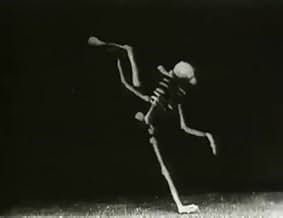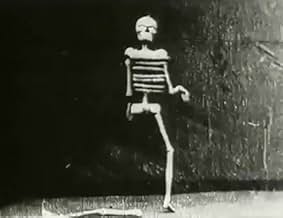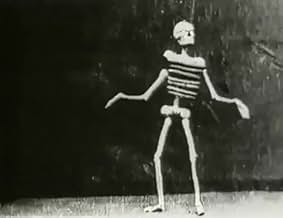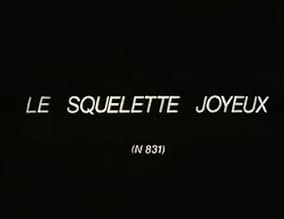Le squelette joyeux
- 1898
- 1min
NOTE IMDb
6,4/10
1,2 k
MA NOTE
Ajouter une intrigue dans votre langueA skeleton dances joyously, often collapsing into a heap of bones and quickly putting itself back together.A skeleton dances joyously, often collapsing into a heap of bones and quickly putting itself back together.A skeleton dances joyously, often collapsing into a heap of bones and quickly putting itself back together.
- Réalisation
Avis à la une
'The Merry Skeleton (1898)' depicts a happy skeleton busting some moves on the dance floor, unfazed whenever a bone falls out of place. The piece is pretty enjoyable for what it is, a silly little sideshow featuring a skeleton on a string and some camera tricks to make it seem as though it's putting itself back together after it falls apart. There isn't much to it, but it's pleasant enough and carries a lot of historical weight. I can imagine this delighting quite a few people, especially children, back in its day. 6/10.
A common misconception is that motion pictures give the illusion of life; to the contrary, its illusion is one of death. Indeed, André Bazin, in "The Ontology of the Photographic Image," theorized cinema as mummification, a practice of embalming the dead. In traditional live-action cinema, life and motion is captured, made dead and still series of photographs, before being reanimated and projected on a screen like some grotesque Frankenstein monster--or a dancing skeleton. Lumière wasn't the first to realize this, either. For centuries before the Cinématographe was invented, there was the screen practice of the magic lantern, or "the lantern of fear," as it was otherwise known. Perhaps, the first such lantern slide, as illustrated by Christiaan Huygens in 1659, was of a skeleton given the illusion of macabre movement (see Laurent Mannoni's "The Great Art of Light and Shadow: Archaeology of the Cinema"). Later, a band of sequential images was given the illusion of motion by rapid succession via intermittent movement in Beale's Choreutoscope; the most famous of these are six images of a dancing skeleton (reprinted in Brian Coe's "The History of Movie Photography" and elsewhere). There was also Robertson's Phantasmagoria, which employed back-projected lantern slides moving on tracks to frighten spectators with approaching skeletons and other jump scares. It's appropriate, then, too, that when Disney further or re-popularized hand-drawn animation that the studio's first "Silly Symphony" should've been "The Skeleton Dance" (1929).
As for this Lumière film of the supposedly "cheerful" or "merry" "Dancing Skeleton," its also been misattributed as an early example of stop-motion animation, although I think it's rather obvious that it's a marionette (and it's labeled as such in the Lumière catalogue (398, vue no. 831)) worked by an unseen operator, which aptly was also the case with the Cinématographe. It's also something of a puzzle as to why such puppetry is ever classified as animation like the hand-drawn or even stop-motion sort. It's live-action cinematography of an inanimate, dead object animated in real time for the view of the camera--not still drawings or images brought to life only during projection. In that sense, this is akin to the actualities that make up most of the Lumière catalogue and is what distinguishes this "Dancing Skeleton" from some magic lantern precedents or the Disney cartoon. Unlike those from Huygens, Beale, Robertson and Disney, this skeleton once "lived" and danced before the Lumière Cinématographe captured and killed it, only for it, long after everyone involved in making it has since died and for more than a century since it was made, turned into a cinematographic ghost, continually reanimated, broken apart and put back together again and made to dance.
P.S. There's a third mistake that's been made across our present-day internet landscape regarding this film. There seems to have been two "Dancing Skeleton" films made in 1897 or 1898 (the Lumière film is listed as being programmed for a 20 March 1898 screening, but may've been photographed, if not released, earlier), one by Lumière and the other by the American Mutoscope Company, which the AFI catalog gives a release date of November 1897. Besides it or the Lumière film being cannibalized for AM&B's multiple-exposure trick film, "Davy Jones' Locker" (1900), the American Mutoscope film seems to be lost despite what some YouTube or Letterboxd posts might otherwise imply.
As for this Lumière film of the supposedly "cheerful" or "merry" "Dancing Skeleton," its also been misattributed as an early example of stop-motion animation, although I think it's rather obvious that it's a marionette (and it's labeled as such in the Lumière catalogue (398, vue no. 831)) worked by an unseen operator, which aptly was also the case with the Cinématographe. It's also something of a puzzle as to why such puppetry is ever classified as animation like the hand-drawn or even stop-motion sort. It's live-action cinematography of an inanimate, dead object animated in real time for the view of the camera--not still drawings or images brought to life only during projection. In that sense, this is akin to the actualities that make up most of the Lumière catalogue and is what distinguishes this "Dancing Skeleton" from some magic lantern precedents or the Disney cartoon. Unlike those from Huygens, Beale, Robertson and Disney, this skeleton once "lived" and danced before the Lumière Cinématographe captured and killed it, only for it, long after everyone involved in making it has since died and for more than a century since it was made, turned into a cinematographic ghost, continually reanimated, broken apart and put back together again and made to dance.
P.S. There's a third mistake that's been made across our present-day internet landscape regarding this film. There seems to have been two "Dancing Skeleton" films made in 1897 or 1898 (the Lumière film is listed as being programmed for a 20 March 1898 screening, but may've been photographed, if not released, earlier), one by Lumière and the other by the American Mutoscope Company, which the AFI catalog gives a release date of November 1897. Besides it or the Lumière film being cannibalized for AM&B's multiple-exposure trick film, "Davy Jones' Locker" (1900), the American Mutoscope film seems to be lost despite what some YouTube or Letterboxd posts might otherwise imply.
I found this film on YouTube when I was watching some Georges Méliès films. I can only assume someone looked at the style and assumed it was one of his pictures...which isn't at all surprising. What IS surprising is that it was made by one of the Lumière brothers...who were known for much more mundane sorts of pictures than "The Merry Skeleton".
In "The Merry Skeleton" an obviously fake skeleton dances about on a string. However, by stopping and restarting the camera, you see parts of the skeleton fall off and magically reattach themselves. A cute trick for its day...and mildly enjoyable today.
In "The Merry Skeleton" an obviously fake skeleton dances about on a string. However, by stopping and restarting the camera, you see parts of the skeleton fall off and magically reattach themselves. A cute trick for its day...and mildly enjoyable today.
This short film is hilarious! It is just a skeleton dancing, but he's so clumsy that makes it funny. I actually laughed at this one, which is very rare in this early short films. This Auguste & Louis Lumière film is the most creative and best edited film of the early cinema. Sincerely, I don't know how this is not the most famous film of the Lumière Brothers. I also rated L'arrive dun train with 10 out of 10, but just because these re pieces of history. These are the great images of the dawn of cinema. It certainly shows us the importance of the brothers in cinema, them, LePrince, Edison, William Dickinson and others made one of the most beautiful things ever, the motion picture. I like to watch this early films, I believe every cinephile does and this is probably the funniest of them, I thing people should valorize these films more.
Le Squelette Joyeux (1898)
Long before Disney had THE SKELETON DANCE, there was this forty-second film from the Lumiere Brothers. Basically we see a skeleton (attached to wires) dancing around. As it dances faster and faster parts of it begin to fall off and then attach itself back to the body. This certainly isn't the work of Georges Melies but it's still pretty darn good and it's certainly very entertaining. It's obvious to see how the dance is being done but this really doesn't take away from the entertainment factor and especially when you consider when this was made. The goal was to make viewers laugh and I'm sure many did back in the day, although the sight of the skeleton might have scared some as well.
Long before Disney had THE SKELETON DANCE, there was this forty-second film from the Lumiere Brothers. Basically we see a skeleton (attached to wires) dancing around. As it dances faster and faster parts of it begin to fall off and then attach itself back to the body. This certainly isn't the work of Georges Melies but it's still pretty darn good and it's certainly very entertaining. It's obvious to see how the dance is being done but this really doesn't take away from the entertainment factor and especially when you consider when this was made. The goal was to make viewers laugh and I'm sure many did back in the day, although the sight of the skeleton might have scared some as well.
Le saviez-vous
- AnecdotesThe film is also known as "The Dancing Skeleton".
- ConnexionsEdited into The Lumière Brothers' First Films (1996)
Meilleurs choix
Connectez-vous pour évaluer et suivre la liste de favoris afin de recevoir des recommandations personnalisées
Détails
- Date de sortie
- Pays d’origine
- Langue
- Aussi connu sous le nom de
- The Dancing Skeleton
- Société de production
- Voir plus de crédits d'entreprise sur IMDbPro
- Durée1 minute
- Couleur
- Mixage
Contribuer à cette page
Suggérer une modification ou ajouter du contenu manquant

Lacune principale
By what name was Le squelette joyeux (1898) officially released in Canada in English?
Répondre


















